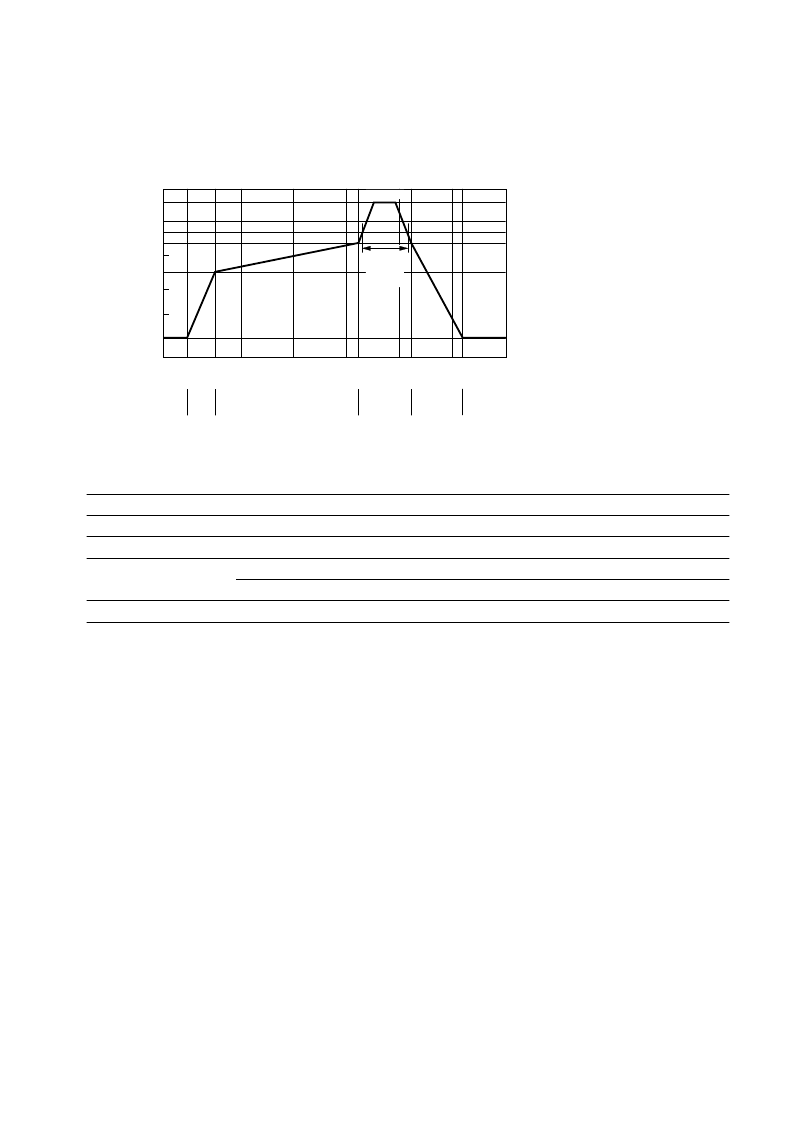- 您現(xiàn)在的位置:買賣IC網(wǎng) > PDF目錄385394 > HSDL-9001 (Avago Technologies Ltd.) Miniature Surface-Mount Ambient Light Photo Diode PDF資料下載
參數(shù)資料
| 型號: | HSDL-9001 |
| 廠商: | Avago Technologies Ltd. |
| 英文描述: | Miniature Surface-Mount Ambient Light Photo Diode |
| 中文描述: | 微型表面貼裝環(huán)境光光電二極管 |
| 文件頁數(shù): | 7/12頁 |
| 文件大小: | 106K |
| 代理商: | HSDL-9001 |

7
Figure 6. Reflow graph.
Reflow Profile
The reflow profile is a straight-
line representation of a nominal
temperature profile for a con-
vective reflow solder process.
The temperature profile is divided
into four process zones, each
with different
T/
time tempera-
ture change rates. The
T/
time
rates detailed in the above table.
The temperatures are measured
at the component to printed
circuit board connections.
In
process zone P1
, the PC
board and I/O pins are heated to
a temperature of 160
°
C to
activate the flux in the solder
paste. The temperature ramp up
rate, R1, is limited to 4
°
C per
second to allow for even heating
of both the PC board and HSDL-
9001 I/O pins.
Process
Heat Up
Solder Paste Dry
Solder Reflow
Symbol
P1, R1
P2, R2
P3, R3
P3, R4
P4, R5
T
25
°
C to 160
°
C
160
°
C to 200
°
C
200
°
C to 255
°
C (260
°
C at 10 seconds max.)
255
°
C to 200
°
C
200
°
C to 25
°
C
Maximum
T/
time
4
°
C/s
0.5
°
C/s
4
°
C/s
–6
°
C/s
–6
°
C/s
Cool Down
Process zone P2
should be of
sufficient time duration (60 to
–120 seconds) to dry the solder
paste. The temperature is raised
to a level just below the liquidus
point of the solder, usually
200
°
C (392
°
F).
Process zone P3
is the solder
reflow zone. In zone P3, the
temperature is quickly raised
above the liquidus point of solder
to 255
°
C (491
°
F) for optimum
results. The dwell time above the
liquidus point of solder should be
between 20 and 60 seconds. It
usually takes about 20 seconds to
assure proper coalescence of the
solder balls into liquid solder and
the formation of good solder
connections. Beyond a dwell time
of 60 seconds, the intermetallic
growth within the solder
connections becomes excessive,
resulting in the formation of weak
and unreliable connections. The
temperature is then rapidly
reduced to a point below the
solidus temperature of the solder,
usually 200
°
C (392
°
F), to allow
the solder within the connections
to freeze solid.
Process zone P4
is the cool down
after solder freeze. The cool down
rate, R5, from the liquidus point of
the solder to 25
°
C (77
°
F) should
not exceed –6
°
C per second
maximum. This limitation is
necessary to allow the PC board
and transceiver’s castellation I/O
pins to change dimensions evenly,
putting minimal stresses on the
HSDL-9001.
0
t-TIME (SECONDS)
T
°
C
230
220
200
180
160
120
80
50
150
100
200
250
300
255
P1
HEAT
UP
P2
SOLDER PASTE DRY
P3
SOLDER
REFLOW
P4
COOL
DOWN
25
R1
R2
R3
R4
R5
60 sec.
MAX.
ABOVE
217
°
C
MAX. 260
°
C
相關(guān)PDF資料 |
PDF描述 |
|---|---|
| HSDL-9100 | Surface-Mount Proximity Sensor |
| HSDL-9100-001 | Surface-Mount Proximity Sensor |
| HSDL-9100-021 | Surface-Mount Proximity Sensor |
| HSH1205D | DC/DC CONVERTERS 12 VOLT INPUT |
| HSMA-A400-T35M1 | SMT LED Surface Mount LED Indicator |
相關(guān)代理商/技術(shù)參數(shù) |
參數(shù)描述 |
|---|---|
| HSDL-9100 | 制造商:Avago Technologies 功能描述:Bulk |
| HSDL-9100_09 | 制造商:AVAGO 制造商全稱:AVAGO TECHNOLOGIES LIMITED 功能描述:Surface-Mount Proximity Sensor |
| HSDL-9100-001 | 制造商:Avago Technologies 功能描述: |
| HSDL-9100-021 | 功能描述:板機(jī)接口移動感應(yīng)器和位置傳感器 Proximity Sensor RoHS:否 制造商:Panasonic Electric Works 封裝 / 箱體:TO-5 感應(yīng)距離:3 m 輸出類型:Digital 電源電壓-最大:6 V 電源電壓-最小:2.3 V 電源電流: 最大工作溫度:+ 60 C 封裝:Bulk |
| HSDL-9100-024 | 功能描述:近程傳感器 Proximity Sensor RoHS:否 制造商:Vishay Semiconductors 感應(yīng)方式:Optical 感應(yīng)距離:1 mm to 200 mm 電源電壓:2.5 V to 3.6 V 安裝風(fēng)格:SMD/SMT 輸出配置:Digital 最大工作溫度:+ 85 C 最小工作溫度:- 25 C 系列:VCNL3020 |
發(fā)布緊急采購,3分鐘左右您將得到回復(fù)。